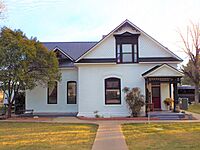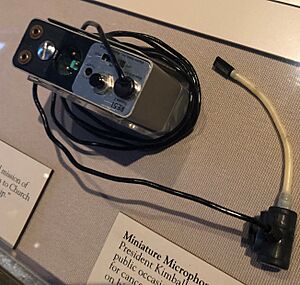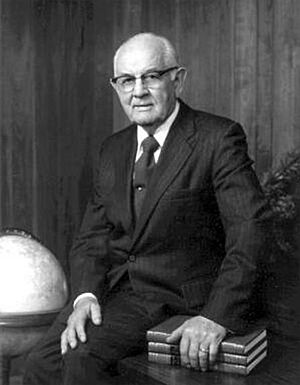Spencer W. Kimball facts for kids
Quick facts for kids Spencer W. Kimball |
|
|---|---|
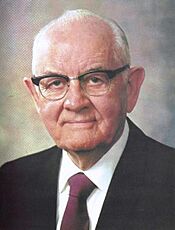 |
|
| 12th President of the Church of Jesus Christ of Latter-day Saints | |
| December 30, 1973 – November 5, 1985 | |
| Predecessor | Harold B. Lee |
| Successor | Ezra Taft Benson |
| President of the Quorum of the Twelve Apostles | |
| July 7, 1972 – December 30, 1973 | |
| Predecessor | Harold B. Lee |
| Successor | Ezra Taft Benson |
| End reason | Became President of the Church |
| Acting President of the Quorum of the Twelve Apostles | |
| January 23, 1970 – July 2, 1972 | |
| Reason | Harold B. Lee was serving as First Counselor in the First Presidency to Joseph Fielding Smith |
| End reason | Became President of the Quorum of the Twelve Apostles |
| Quorum of the Twelve Apostles | |
| October 7, 1943 – December 30, 1973 | |
| Called by | Heber J. Grant |
| End reason | Became President of the Church |
| LDS Church Apostle | |
| October 7, 1943 – November 5, 1985 | |
| Called by | Heber J. Grant |
| Reason | Deaths of Sylvester Q. Cannon and Rudger Clawson |
| Reorganization at end of term |
Joseph B. Wirthlin ordained |
| Personal details | |
| Born | Spencer Woolley Kimball March 28, 1895 Salt Lake City, Utah Territory, U.S. |
| Died | November 5, 1985 (aged 90) Salt Lake City, Utah, U.S. |
| Resting place | Salt Lake City Cemetery 40°46′37.9″N 111°51′28.8″W / 40.777194°N 111.858000°W |
| Education | Secondary Education, 1914, Gila Junior College |
| Spouse(s) |
Camilla Eyring
(m. 1918) |
| Children | 4 |
| Signature | |
Spencer Woolley Kimball (born March 28, 1895, died November 5, 1985) was an important American religious leader. He was the twelfth president of The Church of Jesus Christ of Latter-day Saints (LDS Church). Spencer was the grandson of Heber C. Kimball, an early leader in the Church. He was born in Salt Lake City, Utah Territory.
He grew up in Thatcher, Arizona, where his father, Andrew Kimball, was a farmer and a Church leader. Spencer served as a missionary in Missouri from 1914 to 1916. After his mission, he worked in banks in Arizona. Later, he started a successful business selling bonds and insurance. From 1938 to 1943, Spencer led a group of Church congregations as a stake president. In 1943, he was asked to become a member of the Quorum of the Twelve Apostles.
Like other Church apostles, Spencer W. Kimball traveled a lot to do his Church duties. Early in his service, Church president George Albert Smith asked him to focus on helping Native Americans. Spencer worked on this throughout his life. He started the Indian Placement Program. This program helped many Native American students get an education in the 1960s and 1970s. They lived with Church families who became their foster parents.
In late 1973, after Harold B. Lee passed away, Spencer W. Kimball became the twelfth president of the Church. He served in this role until he died in 1985. A major event during his presidency was the 1978 announcement. This announcement ended a restriction that had prevented Black African men from holding the priesthood or receiving temple blessings. The Church grew a lot during Spencer W. Kimball's time as president, both in members and in the number of temples. He was also the first Church president to publicly state that all healthy young men should serve missions. This led to many more young men serving missions.
Contents
Early Life and Education (1895–1916)
Spencer W. Kimball was born on March 28, 1895, in Salt Lake City, Utah Territory. His parents were Andrew Kimball and Olive Woolley. He had ten brothers and sisters. In 1898, when Spencer was three, his father was called to lead a large group of Church congregations in Arizona. So, his family moved to Thatcher, Arizona.
As a child, Spencer had several health problems, including typhoid fever and face paralysis. He also almost drowned once. Four of his sisters died when they were children, and his mother passed away when he was eleven. Even though he was only about 5 feet 6 inches tall as an adult, Spencer loved basketball. He was often the best player and top scorer on his school teams. He was also a very good student at the Church's Gila Academy, which is now Eastern Arizona College. During summer breaks, he worked at a dairy farm, milking cows and cleaning.
Spencer finished high school in May 1914. A week later, he was called to serve as a missionary in Switzerland and Germany. But less than two months later, World War I started. Because of the war, his mission in Europe was cut short. He was then sent to serve his mission in Missouri until 1916.
Marriage and Early Career (1917–1925)
|
Camilla Eyring
|
|
|---|---|
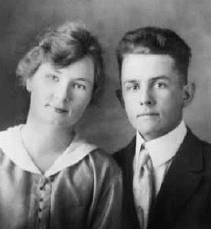
Newlyweds Spencer Kimball and Camilla Eyring (1917)
|
|
| Born |
Camilla Eyring
December 7, 1894 Colonia Juárez, Chihuahua, Mexico
|
| Died | September 20, 1987 (aged 92) |
| Spouse(s) |
Spencer W. Kimball
(m. 1918; died 1985) |
| Parent(s) | Edward Christian (father) Caroline Cottam Romney (mother) |
Spencer wanted to become a schoolteacher. He studied at the University of Arizona for one semester in 1917. But then he received a notice that he might be drafted into the army. Around this time, he started dating Camilla Eyring (1894–1987). She was a schoolteacher at Gila Academy, where Spencer had gone to high school. They started dating in August 1917. They wrote letters often after Spencer left for a semester at Brigham Young University (BYU). After a month at BYU, Spencer learned he might be called to the army soon. He had to leave the university and go back home. He returned to Arizona, but his army group was never called for duty before World War I ended in November 1918.
Spencer and Camilla's relationship grew quickly, and they decided to get married by late October. They didn't have enough money to travel to Utah to get married in an LDS temple. So, they had a civil ceremony at Camilla's home in Pima, Arizona, on November 16, 1917. Seven months later, they traveled by train to Salt Lake City. There, they were sealed in the Salt Lake Temple on June 7, 1918. They had four children: Spencer L. "Spence" (1918–2003), Olive Beth "Bobby" (1922–2018), Andrew E. (1927–2020), and Edward L. "Ed" (1930–2016).
In 1921, Spencer started working at a bank in Thatcher. He was promoted to assistant cashier, earning a good salary for that time. The bank failed in 1923, and Spencer lost his investments. He had to take a lower-paying job at another bank. He also did other jobs to earn money for his family. He played piano and sang at events, wrote for local newspapers, and did clerical work for stores.
Soon after Spencer married, his father asked him to be a clerk for the St. Joseph Stake. In the 1920s, local clerks kept many records and reports. This is now done digitally at the Church's main offices. Being a stake clerk was a part-time job, and they were paid a monthly salary.
Business and Church Leadership (1925–1943)
In 1925, Spencer and Joseph W. Greenhalgh started a small business. They made and bought loans from local businesses and people. By 1927, the business became independent. Spencer invested his own money and started running it full-time in Safford, Arizona. It was called the Kimball–Greenhalgh Agency. They handled insurance, real estate, and debt collection. The business struggled a lot during the Great Depression from 1930 to 1933. But they kept working hard and reinvesting profits. The business survived and became very successful in the late 1930s and early 1940s. By 1943, Spencer's first investment was worth a lot more.
Spencer was active in many community groups. These included the Parent-Teacher Association, city council, Red Cross, and Boy Scouts. In 1936, he was elected leader of the Arizona Rotary Club. He was very good at starting new Rotary Club chapters. The Arizona members voted to pay for him and his wife to go to the club's international meeting in Nice, France, in 1936. They traveled by train to Chicago and then to Montreal. Their oldest son, Spencer L., was serving a mission there. They then took an ocean liner to France. From there, they visited many European cities like Paris, Rome, Venice, and London.
In February 1938, Church leader Melvin J. Ballard came to Thatcher. He divided the growing St. Joseph Stake into two. The new Mount Graham Stake covered the eastern part of the old stake. Spencer was called to be its first stake president. Even though it was smaller, the new stake covered a large area, reaching as far as El Paso, Texas. Spencer and his two helpers had to travel about 1,750 miles to visit every congregation in the stake. In September 1941, heavy rains caused the Gila River to flood. This damaged many towns in the stake and caused a lot of damage to Church members' farms and buildings. As stake president, Spencer helped organize the Church's efforts to help. They quickly provided money, supplies, and people to help those affected and start rebuilding.
After the Japanese attack on Pearl Harbor in December 1941, the United States entered World War II. Many young men from the stake joined the US military. At one point, 250 men from the stake were serving in the war. Spencer made sure that each of them received a copy of the monthly stake newsletter. He often wrote personal notes on each copy.
Spencer was well-known and respected in his community. People often stopped him on the streets of Safford to ask for his advice. After he became stake president, non-Mormon residents and travelers often asked him to perform marriages for them. Spencer's busy schedule of managing his business, serving in community groups, and leading in the Church was very demanding. He also made time for his wife and children. This took a toll on his health. His journals from the 1930s and early 1940s often mention how tired he was from working 16 hours or more each day.
Apostolic Service (1943–1973)
Becoming an Apostle
In mid-1943, two leaders in the Church's Quorum of the Twelve Apostles passed away. On July 8, 1943, Spencer received a phone call from J. Reuben Clark. He was told that he had been called to fill one of the open positions. Spencer was so surprised that he asked for a few days to think about it. He felt unsure and unworthy of such a big calling. His wife, Camilla, said that he cried uncontrollably, even though he rarely cried. After a difficult emotional and spiritual struggle, Spencer had a dream that gave him peace. He felt ready to accept the calling. He was ordained an apostle by Church president Heber J. Grant in the Salt Lake Temple on October 7, 1943. Grant had also chosen Ezra Taft Benson to fill the other vacancy. Spencer and Ezra were ordained on the same day. Spencer was four years older than Ezra, so he was ordained first. This put him ahead of Ezra in the Quorum's seniority.
According to Church rules, the Kimballs immediately started moving from Arizona to Salt Lake City. Spencer sold his share in his business and sold their home and other property in Arizona. Spencer was sad to leave his Rotary Club and other professional groups. Camilla worried about leaving her elderly parents in Arizona. She also worried about moving their second son, Andrew, who had just been elected senior class president at his high school.
Helping Native Americans
 For more information, see Indian Placement Program.
For more information, see Indian Placement Program.
In May 1945, soon after becoming Church president, George Albert Smith told Spencer, "I want you to look after the Indians—they are neglected. Take charge and watch after the Indians in all the world." Spencer felt this was a fulfillment of a blessing he received when he was eight years old. That blessing said he would "preach the Gospel to many people, but more especially to the Lamanites." This term refers to a people in the Book of Mormon who Latter-day Saints believe are ancestors of modern Native Americans. In September 1946, George Albert Smith again asked Spencer to care for the indigenous people of the Americas. This time, he also included the indigenous peoples of the Pacific islands.
In October 1946, Spencer and other Church leaders visited the Navajo Nation. They wanted to improve relations between the Church and the Navajo people. Spencer was saddened by the extreme poverty among the Navajo. He understood their distrust of the U.S. government. At that time, the average Navajo person ate very little each day. Only one dentist served the entire population of 55,000 people. The Navajo Nation reservation was huge, but only a tiny part of it could be farmed. In 1947, a Church leader named Golden Buchanan heard about a 17-year-old Navajo girl. She was working on a farm and wanted to stay in Utah to go to public school. Buchanan wrote to Spencer with an idea. He suggested that children from Navajo families could live with local Church families. This way, they could get good food and an education. Spencer supported the idea. He asked Buchanan if his family would take Helen John, the Navajo girl, as a foster daughter. Buchanan's family agreed. This was the start of the Church's Indian Placement Program. By 1954, the program had 68 students. By 1969, nearly 5,000 students were placed with Church families across the Western United States and Canada.
Spencer was especially upset by the racism against Native Americans that was common among white Church members in the 1940s and 1950s. At the Church's April 1954 general conference, Spencer openly spoke against prejudice. He compared prejudiced Church members to the Pharisees who mistreated Jesus and the priest and Levite from the parable of the Good Samaritan. He repeated his warning at a BYU event. He said there were "too many Pharisees among the white [students and faculty]... too many Levites who pull their robes about them and pass by with disdain."
Personal Counseling
When Spencer was not traveling to visit missions or lead conferences, he spent weekdays answering letters at home or working at Church headquarters in Salt Lake City. He was known among the apostles for meeting with Church members who had serious personal problems. This included married couples thinking about divorce or people who wanted to confess serious mistakes. During his time as an apostle, Spencer met with thousands of Church members and full-time missionaries. They felt their local Church leaders could not help them. Spencer "had no patience for sin [but] almost infinite patience for sinners." He often spent many hours with people who were very distressed. His experiences led him to write The Miracle of Forgiveness, published in 1969.
Health Challenges
From 1932, Spencer suffered from painful skin infections. These continued until new medicines like penicillin became available during World War II.
In May 1948, while visiting Church meetings in Arizona, Spencer had severe chest pain from a heart attack. This happened after he tried to lift a car out of deep sand. He felt tired for the rest of the trip. After he returned to Salt Lake City, his doctor told him to rest for a month. Spencer was only 53 and thought he was healthy. He asked his doctor not to tell the other apostles or the First Presidency. However, on his next assignment, he had chest pains again. This led to another heart attack a few days later. During these early heart problems, Spencer talked with his wife about their family's money, in case he didn't survive. After receiving a special blessing from Church president George Albert Smith, Spencer rested for two months. He then spent several weeks recovering with his wife near the ocean in California. A heart doctor believed his heart had been weakened by an undiagnosed case of rheumatic fever as a child. He told Spencer to avoid overworking and gaining weight. Spencer's chest pains came back sometimes, especially when he was stressed or tired.
In early 1950, when he was 55, Spencer started having a persistent hoarse voice. He had never smoked. After an exam, he had a biopsy of a white spot in his throat. The biopsy caused some temporary voice problems. It showed he had a throat infection but not cancer. In late 1956, his hoarseness returned, with occasional bleeding. His doctor sent him to New York City to see an expert on head and neck cancers. This doctor did another biopsy, which showed "borderline malignancy" (a sign of possible cancer). In early 1957, the doctor recommended immediate surgery. Spencer had not asked Church president David O. McKay for approval for his 1957 biopsy. He felt that as an apostle, he should have asked for approval before having surgery that could affect his ability to speak and serve.
President McKay said he believed Spencer could still serve as an apostle even if he had a complete voice box removal. He advised him to go ahead with the procedure. The doctor then surgically removed one of Spencer's vocal cords and half of the other. This left him barely able to speak above a hoarse whisper. After several weeks of not speaking, Spencer slowly recovered. By November 1957, his doctor allowed him to speak in public again. Spencer's voice remained raspy for the rest of his life. He usually wore a small microphone near his ear to help make his voice louder, even when speaking at pulpits with microphones.
In early 1972, at age 77, Spencer started having trouble breathing, felt very tired, and couldn't sleep well. Doctors found serious hardening of his heart valves and some heart artery disease. At the same time, his throat cancer had returned. He arranged a meeting with his doctors and the Church's First Presidency. One of his doctors, Russell M. Nelson (who later became a Church president), described the meeting:
President Kimball breathlessly began, "I am a dying man. I can feel my life slipping. At the present rate of deterioration I believe that I can live only about two more months. Now I would like my doctor to present his views." Dr. Wilkinson then reaffirmed President Kimball’s feelings, concluding that recovery would be unlikely and death would ensue in the not-too-distant future. Then President Kimball called on me as a cardiac surgeon and asked, "What can surgery offer?" I indicated that an operation, if it were to be done, would consist of two components. First, an aortic valve replacement would be required. Second, an important coronary artery with a blockage should be treated with a bypass graft. President Harold B. Lee of the First Presidency then asked the crucial question, "What would be the risks with such a procedure?" "I don't know," I replied. "In a man aged seventy-seven, the risk of either of these operations is significant. But to do both on one whose heart is failing would entail risk so high that the operation cannot be recommended as a safe one." As a weary President Kimball responded, "I am an old man and ready to die," President Lee interrupted. He rose to his feet, pounded his fist to the desk, and said, with his prophetic power, "Spencer, you have been called! You are not to die! You are to do everything you need to do to care for yourself and continue to live."
President Kimball replied, "Then I will have the operation."
Spencer's heart surgery was delayed so he could have radiation therapy for his throat cancer, which was successful. After the Church's April 1972 general conference, Spencer had a successful 4.5-hour open-heart surgery performed by Dr. Nelson. Spencer spent the next few months recovering.
Church Presidency (1973–1985)
Because of Spencer's health problems, many people, including himself, didn't expect him to live long enough to become president of the Church. However, on December 26, 1973, Harold B. Lee, who was four years younger and had been healthier, died unexpectedly. This made Spencer the most senior apostle, meaning he would become the new Church president. Spencer was ordained Church president on December 30, 1973, the day after Lee's funeral. He chose N. Eldon Tanner and Marion G. Romney as his first and second counselors. Church leader Boyd K. Packer remembered finding Spencer sitting alone in the president's office, weeping quietly. Spencer said to him: "I am such a little man for such a big responsibility!"
Spencer W. Kimball traveled more than any previous Church president. He visited 85 countries around the world. Other important things he did included announcing 27 new temples, dedicating four, and using satellite communication in Church buildings. He also shortened the length of Church services to three hours.
Missionary Work
Spencer W. Kimball was the first Church president to clearly state that all healthy young men in the Church should serve a full-time mission. When he became president in 1974, the Church had 17,000 full-time missionaries. Within a few years, that number grew to 25,000. Also, under his leadership, the number of missionaries in North America increased from 2,000 to 7,000. Between 1976 and 1978, the Church built and dedicated its Missionary Training Center in Provo, Utah. This center is about 1 kilometer north of BYU. New missionaries go there to learn about scriptures, teaching methods, and new languages if needed.
1978 Revelation on Priesthood
 For more information, see 1978 Revelation on Priesthood.
For more information, see 1978 Revelation on Priesthood.
Starting in the late 1840s, men of Black African descent were not allowed to hold the Church's priesthood. The priesthood is usually held by all male members who meet Church standards. They were also not allowed to receive temple blessings like the endowment and celestial marriage. During the 20th century, most Church leaders and members believed this rule started with the founding prophet Joseph Smith. However, Church research in the 1960s and 1970s found no proof of the restriction before the time of Brigham Young. Church presidents Heber J. Grant and David O. McKay privately said that the restriction was temporary. They believed it would be lifted later by a divine revelation to a Church president.
In the years before he became president, Spencer W. Kimball kept notes and articles about this issue. In his first years as president, he often studied and prayed about it. In June 1977, Spencer asked at least three Church leaders to write reports for him. These reports were about the reasons for the restriction and how a change might affect the Church. One leader, Bruce R. McConkie, wrote a long paper. He concluded that there were no scripture reasons to prevent a change. In 1977, Spencer got a special key to the Salt Lake Temple. He would go there in the evenings after the temple closed. He often spent hours alone in the upper rooms, praying for guidance about a possible change. On May 30, 1978, Spencer showed his two counselors a statement he had written. It removed all racial restrictions on holding the priesthood. He said he "had a good, warm feeling about it."
On June 1, 1978, after a monthly meeting of Church leaders in the Salt Lake Temple, Spencer asked his counselors and the ten apostles present to stay for a special meeting. Spencer began by talking about his studies, thoughts, and prayers on removing the restriction. He spoke about his growing feeling that the time for change had come. Spencer asked each man present to share their thoughts. All of them spoke in favor of changing the policy. After everyone had shared their views, Spencer led the apostles in a prayer circle. They prayed to seek final divine approval for the change. As Spencer prayed, many in the group felt a powerful spiritual confirmation. Bruce R. McConkie later said: "There are no words to describe the sensation, but simultaneously the Twelve and the three members of the First Presidency had the Holy Ghost descend upon them and they knew that God had manifested his will.... I had had some remarkable spiritual experiences before... but nothing of this magnitude." L. Tom Perry described: "I felt something like the rushing of wind. There was a feeling that came over the whole group. When President Kimball got up he was visibly relieved and overjoyed." Gordon B. Hinckley later said: "For me, it felt as if a conduit opened between the heavenly throne and the kneeling, pleading prophet of God who was joined by his Brethren."
The Church officially announced the change on June 9, 1978. The news was on many national news broadcasts and on the front page of most American newspapers. In areas with many Latter-day Saints, telephone networks were completely jammed with excited callers. The announcement was formally approved by the Church at the October 1978 general conference. It is now included in the Church's edition of the Doctrine and Covenants as Official Declaration 2.
Equal Rights Amendment
In 1972, the US Congress passed the Equal Rights Amendment (ERA). This amendment would add a rule to the US Constitution. It would guarantee that equal rights could not be denied by the government based on gender. When Spencer W. Kimball became Church president in late 1973, he first told the media that the Church had no official position on the amendment. He did not comment on it. In July 1974, Belle S. Spafford, the leader of the Relief Society (the Church's women's organization), gave a public talk. She said that the amendment's goals could be better reached through laws, not a constitutional amendment. She worried the amendment was too broad. Her successor, Barbara B. Smith, said similar things later that year. This was followed by an article in the Church's Church News supporting her view.
The comments from these two women and the Church News article greatly increased opposition to the ERA in Utah. When the Utah State Legislature voted on its approval in February 1975, it was defeated by a large number of votes. Spencer W. Kimball and his counselors in the First Presidency did not release an official statement on the ERA until October 1976. At that time, the amendment was only four states away from passing. The statement said that the First Presidency understood and "deplore[d]" the unfair treatment women had faced throughout history. But they warned that the amendment would not help women and "could indeed bring them far more restraints and repression." In August 1978, the First Presidency issued a second statement. They said that the ERA's "deceptively simple language ... [encouraged] those who seek a unisex society, [and] an increase in the practice of homosexual and lesbian activities."
News coverage of the Church's opposition to the ERA was often negative. At the October 1980 General Conference, about 30 people protested outside the Salt Lake Tabernacle. When Spencer was presented to the congregation, three women stood and shouted "No! ERA policy, no!" At the dedication of the new temple in Seattle in November 1980, several dozen protesters demonstrated. Small protests continued across the United States at major Church events until June 1982. The time limit for the amendment to be approved by enough states expired, and it did not pass.
Later Years and Passing
On March 28, 1975, his 80th birthday, Spencer said: "I can't believe that I am eighty years old.... I don't feel eighty, and I don't think in those terms." However, he suffered from many health issues, from blurry vision to arthritis in his spine. In July 1979, Spencer had three minor strokes. These were thought to be caused by tiny fibers from his artificial heart valve. They briefly made him unable to move but had little lasting effect. In September 1979, Spencer suddenly lost strength in his body, but his mind remained clear. A scan showed he had bleeding on his brain, but the cause was not found. A brain surgeon drilled a small hole in his skull, and nearly a cup of blood and fluid drained out. Spencer left the hospital 12 days after his operation. He insisted on participating in the October 1979 general conference. In November 1979, he had a similar operation for another, less severe, bleed.
In the summer of 1981, Spencer's health started to get worse quickly. He began to have periods of confusion and difficulty speaking. Realizing his declining health and the poor health of his two counselors, Spencer called Gordon B. Hinckley as an additional counselor. This was to help with the Church's daily administration. Soon after Hinckley's selection, Spencer developed a third brain bleed, more serious than the previous two. The surgery for this left him with occasional difficulty speaking and moving. It also further damaged his vision and hearing. By 1982, Spencer was rarely well enough to appear in public. His leadership as Church president was mostly limited to giving final approval or denial to important Church matters that Hinckley brought to him. However, Spencer still attended at least one session of each semi-annual general conference until his death. At the Sunday afternoon session of the Church's April 1982 general conference, Spencer unexpectedly went to the pulpit to give a short closing message. This was his final public address:
My beloved brothers and sisters, this is a great experience for me. I have waited for this day and hoped for it and believed for it. I have a great love for the people of this Church, and gratitude for the love expressed by them and by all the people of these valleys. So as I express that love for you and for the memory of the great experiences I've had with you, I bear my testimony: this work is divine, the Lord is at the helm, the Church is true, and all is well. God bless you, brothers and sisters, I pray in the name of the Lord Jesus Christ, amen.
In the following years, Spencer would sometimes attend meetings in the Salt Lake Temple. He was able to approve or give direction on important matters, such as calling Russell M. Nelson and Dallin H. Oaks to the Quorum of the Twelve Apostles in 1984. But otherwise, he was mostly unable to do much.
Spencer was mentally alert for his 90th birthday on March 28, 1985. He attended that week's meeting of the First Presidency and the Twelve Apostles in the Salt Lake Temple. In November 1985, he had a recurrence of a bleeding stomach ulcer. His family decided not to have surgery. Spencer W. Kimball passed away shortly after 10:00 p.m. on November 5, 1985, at the age of 90. One of his last things he said, which he repeated several times in the days before his death, was "My life is at an end now. She's so happy, oh so very happy." When asked who "she" was, Spencer pointed to his mother, Olive Woolley Kimball. She had died in 1906, when he was 11.
Spencer W. Kimball's teachings as an apostle were the focus of study in the Church's Sunday classes in 2007.
Awards and Recognition
In 1977, he received the Golden Plate Award from the American Academy of Achievement.
In 1996, a bronze statue of him was unveiled in Arizona. It was commissioned by land developers Gary Walker and Buddy Johnson.
Works
[1]
See Also
 In Spanish: Spencer W. Kimball para niños
In Spanish: Spencer W. Kimball para niños
- The Church of Jesus Christ of Latter-day Saints in Arizona



